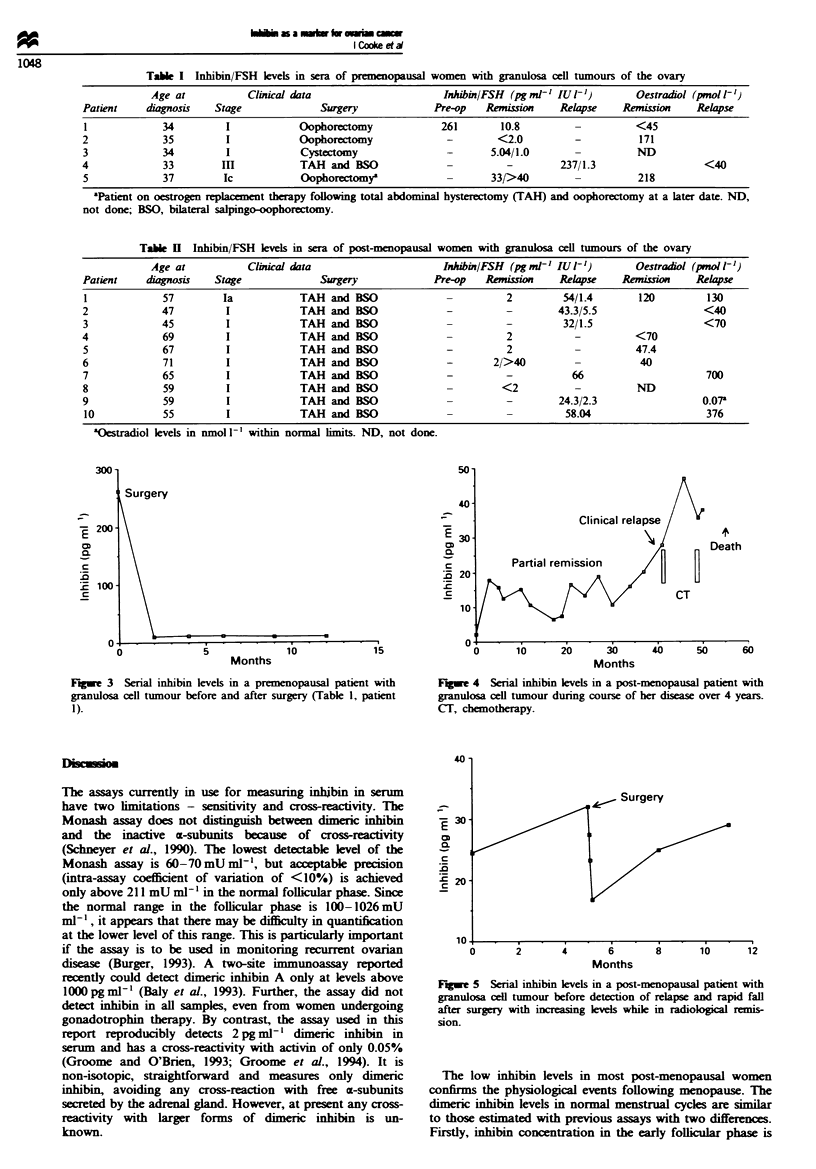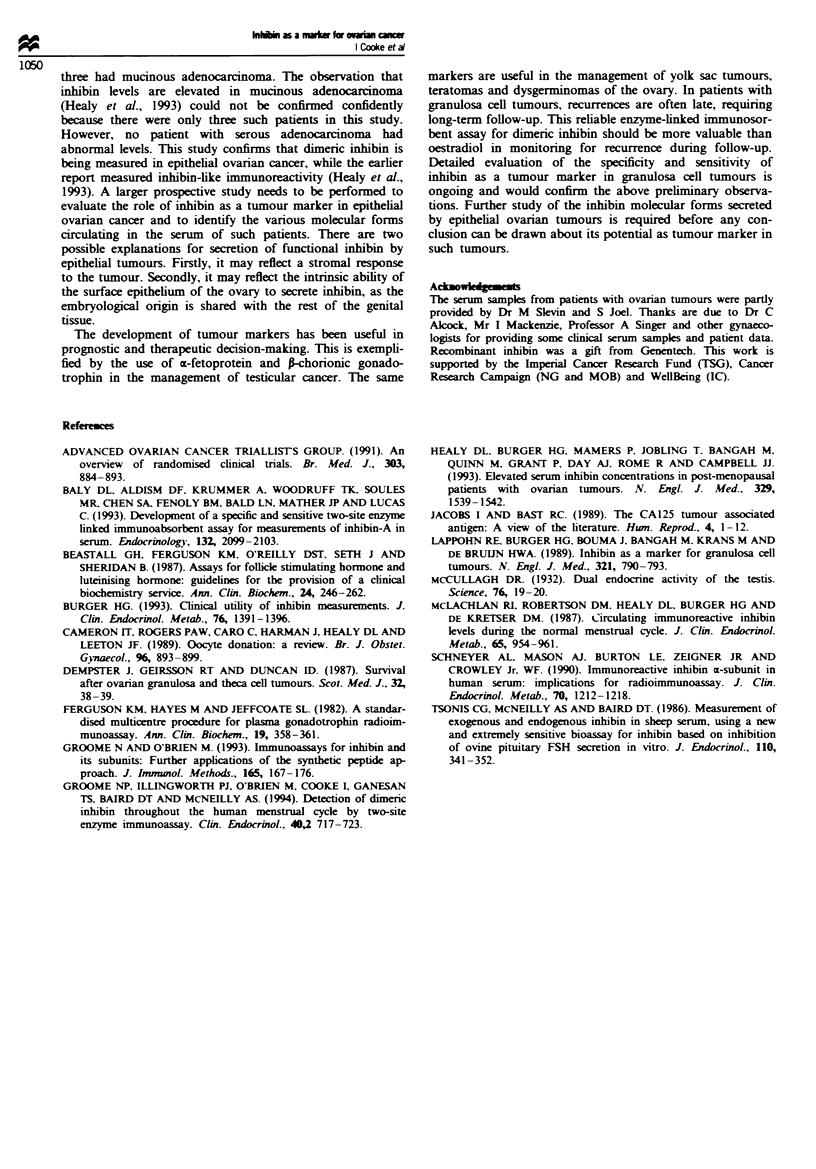Abstract
Inhibin is a polypeptide hormone produced by the granulosa cells of the ovary, and is present in body fluids as dimers of various sizes each comprising an alpha- and beta-subunit. Free forms of the alpha-subunit also circulate, and the presently available radioimmunoassay (Monash assay) cannot distinguish these from biologically active dimeric inhibin. Recently we described a new two-site enzyme immunoassay able for the first time to measure the levels of dimeric inhibin throughout the human menstrual cycle. The sensitivity limit of this assay is 2 pg ml-1 in human serum with cross-reactivity against activin of 0.05%. The normal range of inhibin in post-menopausal women is < 5 pg ml-1, in pre-menopausal women 2-80 pg ml-1 (2-10 pg ml-1 in the follicular phase, 40-80 pg ml-1 in the luteal phase). This assay was used to determine inhibin levels in sera from 15 (five pre-menopausal and ten post-menopausal) patients with granulosa cell tumours of the ovary. It was raised in a pre-menopausal patient preoperatively (261 pg ml-1), in six post-menopausal patients (32, 43, 54, 66, 24 and 58 pg ml-1) and one pre-menopausal patient with recurrent tumour, (237 pg ml-1), all confirmed clinically. Inhibin was normal in six patients in remission. Oestradiol levels were normal in all patients. Serial levels of inhibin predicted recurrence before overt clinical relapse in two patients. In 29 patients with malignant epithelial ovarian tumours inhibin levels were modestly elevated in nine and normal in the rest. Three patients with endometrioid histology, two with undifferentiated tumours, three with mucinous adenocarcinoma and one with clear cell carcinoma had elevated inhibin levels. Functional inhibin is secreted by all granulosa cell tumours of the ovary studied and can be used as a tumour marker to determine response to therapy and predict recurrence and is superior to oestradiol. A more detailed analysis of the levels of inhibin, and its subunits in epithelial ovarian cancer is needed to identify the molecular forms of the immunoreactive material before optimised assays can be applied to this more common tumour.
Full text
PDF




Selected References
These references are in PubMed. This may not be the complete list of references from this article.
- Baly D. L., Allison D. E., Krummen L. A., Woodruff T. K., Soules M. R., Chen S. A., Fendly B. M., Bald L. N., Mathers J. P., Lucas C. Development of a specific and sensitive two-site enzyme-linked immunosorbent assay for measurement of inhibin-A in serum. Endocrinology. 1993 May;132(5):2099–2108. doi: 10.1210/endo.132.5.8477659. [DOI] [PubMed] [Google Scholar]
- Beastall G. H., Ferguson K. M., O'Reilly D. S., Seth J., Sheridan B. Assays for follicle stimulating hormone and luteinising hormone: guidelines for the provision of a clinical biochemistry service. Ann Clin Biochem. 1987 May;24(Pt 3):246–262. doi: 10.1177/000456328702400303. [DOI] [PubMed] [Google Scholar]
- Burger H. G. Clinical review 46: Clinical utility of inhibin measurements. J Clin Endocrinol Metab. 1993 Jun;76(6):1391–1396. doi: 10.1210/jcem.76.6.8501140. [DOI] [PubMed] [Google Scholar]
- Cameron I. T., Rogers P. A., Caro C., Harman J., Healy D. L., Leeton J. F. Oocyte donation: a review. Br J Obstet Gynaecol. 1989 Aug;96(8):893–899. doi: 10.1111/j.1471-0528.1989.tb03342.x. [DOI] [PubMed] [Google Scholar]
- Dempster J., Geirsson R. T., Duncan I. D. Survival after ovarian granulosa and theca cell tumours. Scott Med J. 1987 Apr;32(2):38–39. doi: 10.1177/003693308703200203. [DOI] [PubMed] [Google Scholar]
- Ferguson K. M., Hayes M., Jeffcoate S. L. A standardised multicentre procedure for plasma gonadotrophin radioimmunoassay. Ann Clin Biochem. 1982 Sep;19(Pt 5):358–361. doi: 10.1177/000456328201900507. [DOI] [PubMed] [Google Scholar]
- Groome N. P., Illingworth P. J., O'Brien M., Cooke I., Ganesan T. S., Baird D. T., McNeilly A. S. Detection of dimeric inhibin throughout the human menstrual cycle by two-site enzyme immunoassay. Clin Endocrinol (Oxf) 1994 Jun;40(6):717–723. doi: 10.1111/j.1365-2265.1994.tb02504.x. [DOI] [PubMed] [Google Scholar]
- Groome N., O'Brien M. Immunoassays for inhibin and its subunits. Further applications of the synthetic peptide approach. J Immunol Methods. 1993 Oct 15;165(2):167–176. doi: 10.1016/0022-1759(93)90342-5. [DOI] [PubMed] [Google Scholar]
- Healy D. L., Burger H. G., Mamers P., Jobling T., Bangah M., Quinn M., Grant P., Day A. J., Rome R., Campbell J. J. Elevated serum inhibin concentrations in postmenopausal women with ovarian tumors. N Engl J Med. 1993 Nov 18;329(21):1539–1542. doi: 10.1056/NEJM199311183292104. [DOI] [PubMed] [Google Scholar]
- Jacobs I., Bast R. C., Jr The CA 125 tumour-associated antigen: a review of the literature. Hum Reprod. 1989 Jan;4(1):1–12. doi: 10.1093/oxfordjournals.humrep.a136832. [DOI] [PubMed] [Google Scholar]
- Lappöhn R. E., Burger H. G., Bouma J., Bangah M., Krans M., de Bruijn H. W. Inhibin as a marker for granulosa-cell tumors. N Engl J Med. 1989 Sep 21;321(12):790–793. doi: 10.1056/NEJM198909213211204. [DOI] [PubMed] [Google Scholar]
- McCullagh D. R. DUAL ENDOCRINE ACTIVITY OF THE TESTES. Science. 1932 Jul 1;76(1957):19–20. doi: 10.1126/science.76.1957.19. [DOI] [PubMed] [Google Scholar]
- McLachlan R. I., Robertson D. M., Healy D. L., Burger H. G., de Kretser D. M. Circulating immunoreactive inhibin levels during the normal human menstrual cycle. J Clin Endocrinol Metab. 1987 Nov;65(5):954–961. doi: 10.1210/jcem-65-5-954. [DOI] [PubMed] [Google Scholar]
- Schneyer A. L., Mason A. J., Burton L. E., Ziegner J. R., Crowley W. F., Jr Immunoreactive inhibin alpha-subunit in human serum: implications for radioimmunoassay. J Clin Endocrinol Metab. 1990 Apr;70(4):1208–1212. doi: 10.1210/jcem-70-4-1208. [DOI] [PubMed] [Google Scholar]
- Tsonis C. G., McNeilly A. S., Baird D. T. Measurement of exogenous and endogenous inhibin in sheep serum using a new and extremely sensitive bioassay for inhibin based on inhibition of ovine pituitary FSH secretion in vitro. J Endocrinol. 1986 Aug;110(2):341–352. doi: 10.1677/joe.0.1100341. [DOI] [PubMed] [Google Scholar]


